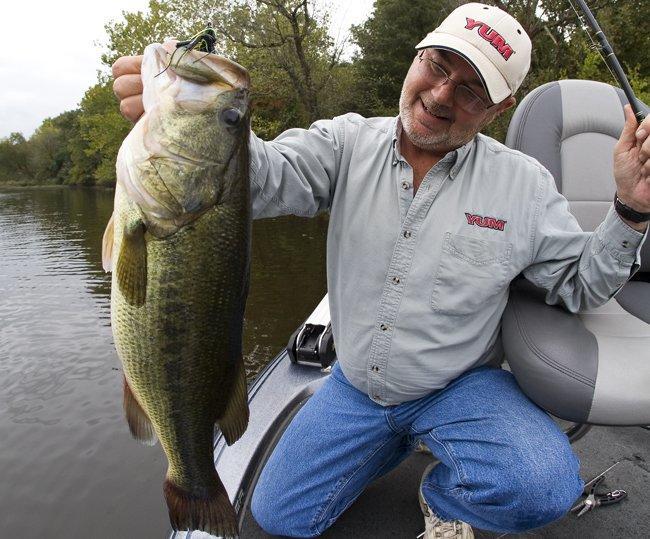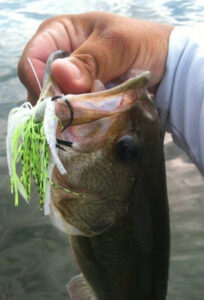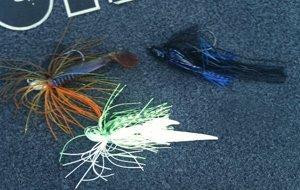A lot of the best techniques are born by accident or maybe by necessity. It’s not in our nature to accept accidents as better ways of doing things. We’re quick to write things off as flukes because of our skeptical nature.
If we were back in college psychology class with a group of anglers, we might do a show of hands to get a representation for how many folks have caught a bass on a jig just reeling it in to make another cast. Then analyze why we think it’s a fluke individually if so many of us have done it.
Happened to you? I bet a bunch of folks answered yes. The fact is a bass is an opportunist and more than that he’s impulsive. Sometimes he’s not hungry, but he’ll bite anyway, and neither the angler nor the bass always know why. That’s the crux of swim jig fishing — a bass reacting to something moving so quickly that he interprets it as something that fears being eaten, and chases it down and grabs it because it must be something worth eating.
We’ll dispense with the bass psychology for now.
I learned to swim a jig back in the late 80s, and for whatever reason, I bucked the normal tendency to write a happenstance occurrence off as a fluke. We were fishing on Lake Dardanelle, a lake off the Arkansas River in Russellville, Ark., and I was pitching a jig into bank grass, pencil reeds or water willows as many folks call them.
I saw a hole up ahead in the grass, so I reeled a jig quickly through the willows, banging stalks as the jig came through to make that next cast. A 4-pounder violently struck the jig and hooked itself before I could even lean into it. It was one of the most violent strikes I’d ever had up to that point in my fishing.
The next cast, I pitched my jig into the hole. Let it sit. Shook it. Then reeled the jig up quickly through the reeds again and another fish swirled and missed the jig this time. That’s because I saw the boil and jerked like a mad man. Yeah I was keyed up. But more importantly I was keyed into the swimming effectiveness of a jig.
Back then I was using a 6 foot rod, 10-pound mono and an Arkie jig. Yep I was out matched and didn’t know any better. Yes I caught a lot of fish swimming a jig. I also lost a lot more.
The History
Fast forward 25 years, and swimming a jig is a prominent pattern in fishing from coast to coast, from Wisconsin to Louisiana. Several folks have laid claim to creating the swim jig or the swim jig technique. I think simultaneously several guys were figuring it out and making jigs specifically designed for this technique to get better hook ups. There were guys in Alabama, Wisconsin, Arkansas and more using this technique 20 years ago and the fact that nothing was written about it back then, makes me believe several guys discovered it by not writing it off as a fluke.
There are a lot of great swim jig anglers that fish at the top level and probably every pro knows how to do it well. But a few names like Randy Howell, Tom Monsoor and Mitch Looper stand out on the topic. While I’ve listened to a very exhaustive class with Randy Howell at Bass University on swimming a jig and saw what he did on Lake Dardanelle in some Elite 50 events, I’ve had the fortune of learning to swim a jig from Looper on the water.
Mitch Looper, is a prostaff angler for PRADCO. Many are familiar with his big bass prowess from the many articles and videos he’s been in over the years. When PRADCO needs a big fish for a photo shoot or a magazine article or a catalog shot, they call Mitch to go get the bass for them. Not to mention he caught a 14-pound bass, one of the largest Northern Strain bass ever recorded on a city lake in Arkansas – on a jig.
Looper started making an arrowhead shaped jig that had a flat surface specifically for swim jig fishing back in the 1980s. He made up a bunch and they were sold along the Arkansas River as word of the swim jig technique was spreading. It remained a regional bait for many years until his design was picked up by Booyah.
The Basic Setup
Like any other technique, you can chuck and wind a jig and catch bass, but there are several little nuances about swimming a jig that will make you a lot more successful, lead to more hookups and help you use your time more wisely.
The first consideration is your equipment. Swim jig fishing is fast and furious and the fish are full of spunk when you hook and fight them to the boat. It’s not a light line, light rod technique. A lot of guys swim a jig with braid. I prefer 17- to 25-pound monofilament for several reasons.
Heavier fluorocarbons can be cumbersome to manage and fish with. They can be rigid, coilly and not perform as well as the same pound test monofilament. And at those higher pound tests, stretch isn’t as big a factor. I will go up to braid though if the cover is overly thick or I think I’m not getting a direct enough pull on the fish with my hookset.
I use a medium-heavy to heavy action 6-foot, 9-inch to 7-foot rod. I really like being able to make roll casts to just beyond specific targets like cuts and corners in the grass, stumps, laydowns, etc. A longer rod can make that a little more cumbersome to do.
A high speed reel is a must. A lot of guys will tell you to use a lighter jig and reel the jig slowly through the grass. That goes against the grain of what we’ve found makes a swim jig so effective.
Speed Kills
The retrieve varies among good swim jig anglers, but one thing that has become apparent over the course of 20 plus years is that speed can be the greatest asset to triggering bites. What separates a swim jig in Looper’s mind is the speed it moves.
“You can reel a spinnerbait slow through the grass with a thumping blade and not get a strike,” Looper said. “The turn around and fire a swim jig through there as fast as you can reel it and catch a giant. It’s a big fish bait if you fish it right.”
Looper has proven that to me over and over again in the boat. But speed doesn’t mean reeling it so fast it’s skiing on the surface or haphazardly just turning the handle as fast as you can without paying attention to the bait. There is an art to each cast.
Like with a spinnerbait, you want to pick those angles that bring your bait right by an ambush point or that maximize its time in the water. When I’m fishing it now around emergent grass, I want the jig to come right by the point that sticks out the furthest in the line of willows. I want it to come through the willows, bumping as many stalks as I can on one retrieve.
Your rod angle can do a lot of the effective work for you. Make your cast then put your rod tip down and in the angle that is going to bring your jig rapidly by the point in the cover you think is the likely ambush spot. Visualize where a bass might setup to attack and then try to hit that spot from multiple angles.
The other nice thing about the speed besides covering a lot of water fast, is that it can also be an alarm to wake the bass up and put them on guard. You make a fast cast, then another, each time getting closer to bass. He’s now on guard because he sees or hears a commotion just down from him in the grass. Now when you race it by him, it’s as if he’s saying, “Ah ha! There it is!”
Mastering the Retrieves
Obviously reeling fast is one way to get them, but it’s more refined. Sure you can bump the cover and get the jig to deflect and change its motion momentarily. The real refinement comes with imparting action but being cautious not to break the surface.
“You want your jig to come by that piece of cover, grass or ambush point as close as possible and swim right against it or through it without breaking the surface,” Looper said. “So many times if you break the surface, you don’t get a bite. If you can keep it just under the surface, waking as it comes up to the cover, it gives the fish a better profile and they seem to take the jig better.”
So it’s speed, it’s contact, it’s bulging but not breaking the water’s surface. But it can also be imparted action.
When I first started swimming a jig, there was something about “pulsing” the jig that really enticed strikes. With a rod up at about 10 o’clock, you can reel fast and just pump the rod tip an inch or two rapidly and repeatedly in a cadence to make the jig just flare for a split second and burst. It looks like you’re almost walking the jig the way the rod tip moves, but really your just pausing it for a split second and the skirt flares and the legs on the trailer kick and then it’s off again. Randy Howell used this retrieve with great success on Lake Dardanelle in the Elite 50 he won in 2004.
The final trick I will impart is a kill for a following fish. Probably the best angler I’ve been in the boat with at catching following fish on a jig is Bill Taylor, FLW Tour director. He’s not a jig swimmer per se, but on numerous occasions he’s caught big bass that followed his casting jig back to the boat as he reeled it quickly to make another cast. Bill quickly reacts to a following bass by dropping his rod, killing the reel, even punching the bail and watching his line. Then when he sees the line jump or change directions he sets and catches them.
I often will pass the prime target in the cover and kill the jig and then rapidly start in again on my retrieve with a rod pop if I don’t see a strike on the line. This has accounted for numerous bass. Also if I deflect nicely off a hard piece of cover, I will kill the jig, give it a few pops and back to reeling. The key is not to just chunk and wind your baits. For a bass it’s often about the directional change that triggers a reaction.
Salad Dressings
Looper keeps his dressings simple. He likes a double banded rattle ahead of the skirt, then the skirt threaded on after. He’ll often use a shad colored for cleaner water and a black and chartreuse for muddy waters.
There are several good swim jigs on the market from Booyah, Buckeye, V&M, Strike King, Taylor Man’s and more if you want some ready to go swim jigs. I often make my own, using heads from BOSS, and I make my own skirts just because I like to have something a little different than the norm. I can do some things like add specific accents, add tails, and other dressings. And I like to wire tie my skirts.
I’ve recently fished the Taylor Man’s swim jigs and had some incredible success on one outing when the lake was 2-foot over summer pool levels and the bank grass had a nice buffer of water on top of it, perfect for swimming a jig. I had some of the prettiest strikes I’ve had all year with this combination.
After head and skirt selection, there is the matter of trailers. Ask five swim jig guys, and they’ll probably give you five different answers on swim jig trailers. The answer is go with your gut. Sometimes a dual tail trailer is good. Sometimes a single tail is better. Some guys like a craw trailer; some guys like a swimbait. This is the part where you can have some fun with a swim jig.
I’ve caught a ton of bass swimming a jig with a single tail grub, a fork tail spinnerbait trailer and a craw trailer. Some of my favorites right now are the twin tail grub and the Zoom Ultravibe Speed Craw.
On my last swim jig outing in June, I was using a chartreuse and white skirt on a Taylor Man’s swim jig and worm with a big tail. That big scythe tail I used like a rudder. It made just a subtle little tail kick as I pulled it over the flooded bank grass.
Sometimes that subtle shad profile is the ticket while other days a darker or more bluegill type color with thumping claws or legs on a trailer work a lot better. Time on the water will be your guide there to find the colors and combinations that work for you on your waters. Keep the speed up, vary the retrieve, pick your targets and angles and experiment with your make up to really dial in the swim jig bite on your fishery. You can fish from pre-spawn all the way to late fall with a swim jig if the cover and grass is right for it.
If you liked this article, here is a more advanced article with four Bassmaster Elite Series pros on How to Fish a Swim Jig Around Other Cover.














